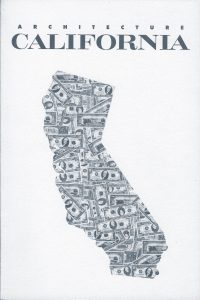
I came to the AIACC Editorial Board in 1989, shortly after Joseph Esherick, FAIA, William Turnbull, FAIA, and Barton Phelps, FAIA, had begun reshaping Architecture California to be more responsive to the shared needs of the readership. During that transformation, it was determined that the journal should more fully exploit its unique role as a service to architects practicing in California.
There were 18 issues published in the 1990s. Each was based on a thematic construction, ranging from The Politics of Design Review to Places for Learning. The majority of the contributing writers were AIACC members dedicated to expressing their views on matters of importance to California architects and the profession. Editorial Board members who served during this 10-year period took time from their busy practices to shepherd specific issues: selecting topics, giving structure to the dialogue and soliciting writers. The three editors—Alicia Rosenthal, AIA, Lian Hurst Mann, AIA, and myself—were architects committed to raising the level of discourse. In addition there were several AIACC Vice Presidents of Communications (Orlando Maione, AIA, Ken Rodrigues, FAIA, Michael Stanton, FAIA, Gordon Chong, FAIA, Steve Castellanos, FAIA, Michael Hricak, FAIA, and David Meckel, FAIA) who advocated support for the journal. As many of you know, there were times when their efforts saved it from elimination. The AIACC staff (including Paul W. Welch, Jr., Hon. AIA, Executive Vice President, Julie Thompson, Hon. AIACC, and Erin Wells, the current Director of Communications) was instrumental in keeping Architecture California on solid ground.
As the journal moves into a new era, it is important to remember some of the factors that brought it to this point. The vision of Esherick, Turnbull and Phelps gave life to the material. That vision positioned Architecture California as not just another trade magazine but a fully refereed scholarly journal. For six years, through the work of editor Lian Hurst Mann, the journal earned local and regional acclaim as well as national recognition. In her words, “Each edition of Architecture California has become a kind of chapbook of primary writings on a particular topic, with many points of view, including those that can contribute to the field for years to come.” Her understanding that architects normally have no real call to be introspective set up the journal as a forum for intellectual exchange based on the rich experience of daily practice.
In 1997, when asked to become the editor of Architecture California, I was honored. I knew, however, that my tenure would be short-term, focused on pushing the journal to the next level of its existence. My goal of having architects write about the passions of practice was realized in the last three issues: Volume 19, Numbers 1 and 2, and Volume 20, Number 1.
While keeping the journal in front of the readers, we spent significant time deciding its new direction. There were two possible scenarios: elimination or creating a sustaining structure for a quarterly journal, with resources and staff to move the agenda to higher ground. Under the leadership of Carol Shen, FAIA, present chair of the Editorial Board, the other Editorial Board members and the AIACC staff, the latter scenario has happened.
As I leave Architecture California, I thank all the people who supported the effort and, more specifically, those who supported my involvement as an Editorial Board member and editor. These years of service to AIACC have been re warding and educational to my role as an academic. It has been a privilege to have this opportunity, and I look forward to arcCA.
Author W. Mike Martin, FAIA, Ph.D., is a professor and vice chair of the Department of Architecture and undergraduate dean of the College of Environmental Design, University of California, Berkeley. He is also principal of CEDAR Consultants.
Originally published in early 2000, in arcCA 00.1, “Zoning Time.”





